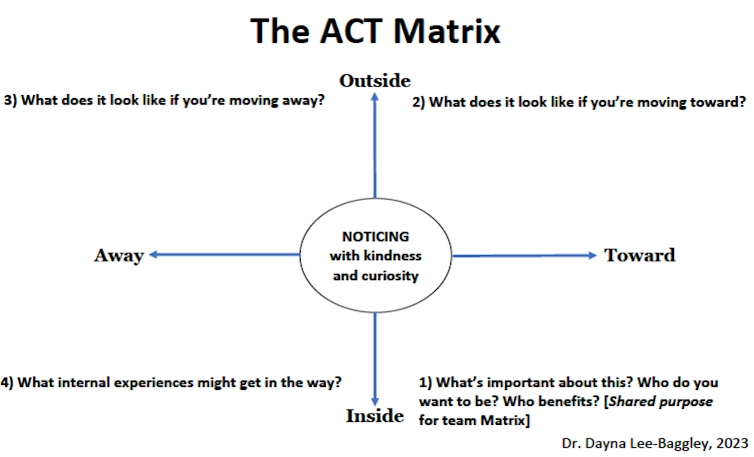Safety and Health Week is May 1 to 6. It offers us a chance to highlight and discuss safety, health and harm prevention in the workplace.
Workplaces have come a long way from a time when safety was equated with physical safety. Occupational health and safety is no longer simply about hardhats and steel-toed work boots — it’s also about psychological safety.
The emotional well-being of workers is critical to the success of any organization. Psychological safety is everyone’s responsibility, but hinges on leadership valuing and facilitating it.
Psychological safety
A psychologically safe workplace is one where it’s OK to make mistakes, it’s OK to not be OK, and it’s OK to speak up and disagree with superiors or other members of your team.
A psychologically safe workplace is where employees feel comfortable taking risks and being themselves without fear of judgment, lateral violence (for example exclusion, bullying) or negative consequences.
A research initiative undertaken by Google called Project Aristotle identified psychological safety as the single most important factor for effective teams.
The project was named after the ancient Greek philosopher Aristotle, who once said “the whole is greater than the sum of its parts.” Aristotle suggested that people who worked together could achieve better results than working alone.
The researchers looked at a range of factors, including team size, member diversity, communication styles and leadership, among others.
Amid worldwide concerns about a lack of equity, diversity, inclusion and accessibility, decreasing levels of retention and productivity and increasing amounts of burnout, committing to creating psychologically safe workplaces is the best way to help employees and teams function most effectively.
Benefits of psychological safety
Current evidence supports that psychological safety is positively associated with workplace engagement, innovation, job performance and job satisfaction — all favourable outcomes for institutions, organizations, the bottom line, clients and the larger community.
These benefits can be obtained through the creation and maintenance of workplaces where employees are able to express themselves, are treated with respect and dignity, and do not experience hierarchical or lateral violence that can include bullying and exclusion.
Creating and maintaining a psychologically safe environment results in employees who are more likely to experience better relationships with colleagues and have better mental health. Choosing psychological safety is choosing to move away from shame and blame and move towards a culture of inclusion, openness and learning.

When a workplace is psychologically safe, it means that employees are comfortable being vulnerable with each other and relying on one another for support. (Shutterstock)
Several recent surveys on disability claims exemplify why employers should invest in employee psychological health and safety.
Telus Health reported that short-term disability claims, due to mental health, increased in prevalence by six per cent and duration by 12 per cent in 2021.
Deloitte found that 30 to 40 per cent of short-term disability claims were due to mental health issues prior to 2020. According to data from Canadian Life and Health Insurance Association members, claims for mental health supports increased by 24 per cent in 2020.
More and more employees consider workplace mental health support a key factor in whether they apply for and accept jobs. A recent survey by the American Psychological Association reported that 81 per cent of survey respondents agreed that employer support for mental health was an important consideration in their job search.
In addition, 30 per cent of respondents strongly agreed that employer support for mental health factored into their job decisions, which increased retention. In a challenging labour market, fostering psychological health and safety is key to attracting and keeping talent.
Psychological safety in ACTion
While it’s clear psychological safety benefits employees and employers, fostering it requires a commitment to learning, unlearning and collaboratively facilitating change over time.
Creating psychological safety also requires a specific set of skills that many workplaces are ill-equipped to foster in leaders and in employees.
The Acceptance and Commitment Therapy (ACT) Matrix is an evidence-based tool designed to help people develop psychological flexibility — the ability to adapt and respond effectively to changing situations and circumstances.
Psychological flexibility includes having the ability to choose our actions, despite difficult inner thoughts and emotions like anger and feelings of distrust.

The matrix asks individuals and teams the following question: Are our actions moving us towards values and people, like colleagues and co-workers, that are important to us? Or are they moving us away from them? (Dayna Lee-Baggley), Author provided
The individual ACT Matrix provides a framework for increasing psychological flexibility, fostering behaviour change and increasing actions that are consistent with our values. It can be an effective intervention for promoting psychological safety in the workplace.
The team ACT Matrix focuses on having a shared purpose (shared values) to orient how members of a team move toward or away from shared purpose. It builds psychological safety by providing a way to communicate respectfully about difficult topics.
The ACT Matrix can increase psychological safety, collaboration, communication and psychological flexibility and reduce stress and emotional distress.
Strategies rooted in ACTion
The ACT Matrix provides us with several practical strategies for building psychological safety:
1) Notice your internal thoughts, feelings, and sensations. Notice how they impact your behaviour in the upper quadrant (for example, do they shut you down? Do you start avoiding or criticizing?). Name them and normalize them. By sharing our observations of our internal experiences, we can normalize them with others and build safety to “be OK not to be OK.” By connecting internal experiences to our behaviour, we can pause and make choices about how we want to show up.
2) Consider choices in terms of “moving towards” or “moving away” from your values, instead of good and bad, right and wrong, or true and false. This is different than setting goals or creating action plans. There is no finish line for psychological safety, we just keep trying to make moves “toward” or contributing to psychological safety.

The ACT Matrix can facilitate meaningful conversations between employees and their colleagues. (Shutterstock)
3) Discuss difficult topics with colleagues in terms of a “shared purpose.” Framing a discussion in terms of shared purpose puts everyone on the same side and allows everyone to come up with behaviours that make sense in the situation and for the people involved. It can also help employees understand the reason behind a colleague’s behaviour (in other words, they may consider that behaviour a move “towards” a shared purpose). This allows us to be our authentic selves in the workplace.
4) We can use the ACT Matrix to identify and name lateral violence in the workplace as “away moves.” Lateral violence equates to a psychologically unsafe environment. This can be bullying, exclusion or freezing people out, belittling others’ opinions, snide comments or remarks, gossiping, mobbing or sharing personal information. Colleagues may not recognize the impact of their behaviour on others. The ACT Matrix allows us to bring up such sensitive topics in the framework of “towards” and “away” moves.
By making use of the ACT Matrix, the complex skills of building psychological safety are broken down into practical steps that can be learned and practised over time.
In this way, employees and employers can take meaningful steps together toward fostering psychological safety in the workplace.
Ron Pizzo, an employment lawyer, co-authored this article.



 U.S. and Rwanda Sign $228 Million Health Partnership to Boost Self-Reliance
U.S. and Rwanda Sign $228 Million Health Partnership to Boost Self-Reliance  FDA Adds Fatal Risk Warning to J&J and Legend Biotech’s Carvykti Cancer Therapy
FDA Adds Fatal Risk Warning to J&J and Legend Biotech’s Carvykti Cancer Therapy  Novartis to Acquire Avidity Biosciences for $12 Billion to Strengthen Rare Muscle Disorder Portfolio
Novartis to Acquire Avidity Biosciences for $12 Billion to Strengthen Rare Muscle Disorder Portfolio  Treasury Wine Estates Shares Plunge on Earnings Warning Amid U.S. and China Weakness
Treasury Wine Estates Shares Plunge on Earnings Warning Amid U.S. and China Weakness  China to Add Eli Lilly’s Mounjaro to National Health Insurance in 2025
China to Add Eli Lilly’s Mounjaro to National Health Insurance in 2025  Apple Explores India for iPhone Chip Assembly as Manufacturing Push Accelerates
Apple Explores India for iPhone Chip Assembly as Manufacturing Push Accelerates  Sanofi’s Efdoralprin Alfa Gains EMA Orphan Status for Rare Lung Disease
Sanofi’s Efdoralprin Alfa Gains EMA Orphan Status for Rare Lung Disease  Eli Lilly’s Weight-Loss Pill Nears Fast-Track FDA Approval as Profits Surge on Global Demand
Eli Lilly’s Weight-Loss Pill Nears Fast-Track FDA Approval as Profits Surge on Global Demand  Novo Nordisk Appoints Greg Miley to Lead Corporate Affairs Amid U.S. Drug Pricing Pressure
Novo Nordisk Appoints Greg Miley to Lead Corporate Affairs Amid U.S. Drug Pricing Pressure  noyb Files GDPR Complaints Against TikTok, Grindr, and AppsFlyer Over Alleged Illegal Data Tracking.
noyb Files GDPR Complaints Against TikTok, Grindr, and AppsFlyer Over Alleged Illegal Data Tracking.  Trump Signs Executive Order to Boost AI Research in Childhood Cancer
Trump Signs Executive Order to Boost AI Research in Childhood Cancer  Delta Air Lines President Glen Hauenstein to Retire, Leaving Legacy of Premium Strategy
Delta Air Lines President Glen Hauenstein to Retire, Leaving Legacy of Premium Strategy  Apple Opens iPhone to Alternative App Stores in Japan Under New Competition Law
Apple Opens iPhone to Alternative App Stores in Japan Under New Competition Law  Biren Technology Targets Hong Kong IPO to Raise $300 Million Amid China’s AI Chip Push
Biren Technology Targets Hong Kong IPO to Raise $300 Million Amid China’s AI Chip Push  Elliott Management Takes $1 Billion Stake in Lululemon, Pushes for Leadership Change
Elliott Management Takes $1 Billion Stake in Lululemon, Pushes for Leadership Change  Pfizer Sues Novo Nordisk Over Alleged Tactics to Block Obesity Drug Competition
Pfizer Sues Novo Nordisk Over Alleged Tactics to Block Obesity Drug Competition 

































